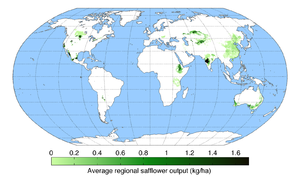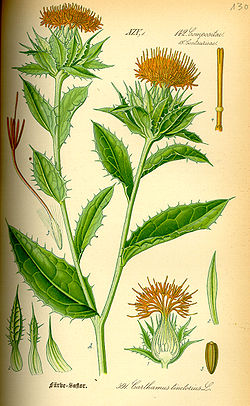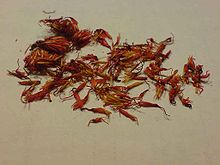- Safflower
-
Safflower 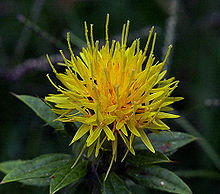
Scientific classification Kingdom: Plantae (unranked): Angiosperms (unranked): Eudicots (unranked): Asterids Order: Asterales Family: Asteraceae Tribe: Cynareae Genus: Carthamus Species: C. tinctorius Binomial name Carthamus tinctorius
(Mohler, Roth, Schmidt & Boudreaux, 1967)[citation needed]Safflower (Carthamus tinctorius L.[1]) is a highly branched, herbaceous, thistle-like annual. It is commercially cultivated for vegetable oil extracted from the seeds. Plants are 30 to 150 cm tall with globular flower heads having yellow, orange or red flowers. Each branch will usually have from one to five flower heads containing 15 to 20 seeds per head. Safflower is native to arid environments having seasonal rain. It grows a deep taproot which enables it to thrive in such environments.
Contents
Uses
Traditionally, the crop was grown for its seeds, and used for colouring and flavouring foods, in medicines, and making red (carthamin) and yellow dyes, especially before cheaper aniline dyes became available.[2] For the last fifty years or so, the plant has been cultivated mainly for the vegetable oil extracted from its seeds. In April 2007 it was reported that genetically modified safflower has been bred to create insulin.[3]
Seed
Safflower seed oil is flavorless and colorless, and nutritionally similar to sunflower oil. It is used mainly in cosmetics and as a cooking oil, in salad dressing, and for the production of margarine. It may also be taken as a nutritional supplement. INCI nomenclature is Carthamus tinctorius.
There are two types of safflower that produce different kinds of oil: one high in monounsaturated fatty acid (oleic acid) and the other high in polyunsaturated fatty acid (linoleic acid). Currently the predominant edible oil market is for the former, which is lower in saturates than olive oil, for example. The latter is used in painting in the place of linseed oil, particularly with white, as it does not have the yellow tint which linseed oil possesses.
Safflower seed is also used quite commonly as an alternative to sunflower seed in birdfeeders, as squirrels do not like the taste of it.
Flower
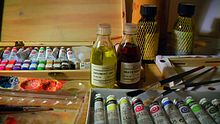 Safflower oil as a medium to oil colours
Safflower oil as a medium to oil colours
Safflower flowers are occasionally used in cooking as a cheaper substitute for saffron, and are thus sometimes referred to as "bastard saffron." Lana is a strain of Safflower that grows in the southwestern United States, most notably Arizona and New Mexico.
In colouring textiles, safflower's dried flowers are used as a natural textile dye. Natural dyes derived from plants are not widely used in industry but it is getting more important world wide because of naturality and fashion trends.[citation needed] The pigment in safflower is benzoquinone-based Carthamin, so it is one of the quinone-type natural dyes. It is a direct dye (CI Natural Red 26) and soluble. Yellow, mustard, khaki, olive green or even red colours can be obtained on textiles, but it is used mostly for yellow colours. All hydrophilic fibres (all natural fibres, such as cotton, wool, etc.) may be dyed with this plant since it may be classified as a direct dye. Polyamide can also be dyed without a mordant agent because of its wool-like chemical structure. Polyester, polyacrylnitryl and others which are hydrophobic synthetic fibres can be dyed only in the existence of a mordant.
Safflower concentrate is an ingredient of the carbonated soft drink Tizer and some types of Sunkist.
Dried Safflower flowers (草红花, 红花) are used in Traditional Chinese medicine to alleviate pain, increase circulation, and reduce bruising. They are included in herbal remedies for menstrual pain and minor physical trauma.[4]
Transgenics
The pharmaceutical company SemBioSys Genetics is currently using transgenic safflower plants to produce human insulin as the global demand for the hormone grows. Safflower-derived human insulin is currently in the PI/II trials on human test subjects.[5]
History
Safflower is one of humanity's oldest crops. Chemical analysis of ancient Egyptian textiles dated to the Twelfth dynasty identified dyes made from safflower, and garlands made from safflowers were found in the tomb of the pharaoh Tutankhamun.[2] John Chadwick reports that the Greek name for safflower occurs many times in Linear B tablets, distinguished into two kinds: a white safflower, which is measured, and red which is weighed. "The explanation is that there are two parts of the plant which can be used; the pale seeds and the red florets."[6]
Safflower was also known as carthamine in the nineteenth century.[7] It is a minor crop today, with about 600,000 tons being produced commercially in more than sixty countries worldwide. India, United States, and Mexico are the leading producers, with Ethiopia, Kazakhstan, China, Argentina and Australia accounting for most of the remainder.
Other names include Sallflower, Beni, Chimichanga, or Carthamus Tinctorius.
Diseases
The safflower, an annual plant, is native to a climate with a long dry season and a limited rainy season. Its defenses are very poor against numerous fungal diseases in rainy conditions, after its seedling stage. This greatly restricts the areas in which it can be grown commercially around the globe.[8] See List of safflower diseases. The plant is also very susceptible to frost injury (from stem elongation to maturity).
See also
- Safflower Princess
- Conjugated linoleic acid
- Tsheringma
- Chinese herbology
Notes
- ^ Safflower - Carthamus tinctorius L
- ^ a b Daniel Zohary and Maria Hopf, Domestication of plants in the Old World, third edition (Oxford: University Press, 2000), p. 211
- ^ BBC NEWS | Health | Firm in GM insulin breakthrough
- ^ 雷载权; 陈松育、高学敏 (1995). 中药学. 上海科学技术出版社. pp. 206. ISBN 7-5323-3706-5.
- ^ Phillip Stephan, SemBioSys Genetics Inc, product bulletin June 2008. http://www.sembiosys.com/pdf/SBS-1723-Product-FS(Insulin).pdf sembiosys.com
- ^ John Chadwick, The Mycenaean World (Cambridge: University Press, 1976), p. 120
- ^ De Candolle, Alphonse. (1885.) Origin of cultivated plants. D. Appleton & Co.: New York, p. 164. Retrieved on 2007-09-25.
- ^ Book Safflower, By Joseph Ronstadt Smith, year 1996, including chapter 6: "Developmental Research".
External links
- Complementary and Alternative Healing University (Chinese Herbology)
- Ahmed M. Zahran, M. F. Omran, S. Z. Mansour and N. K. Ibrahim. Effectiveness of Carthamus tinctorius L. in the Restitution of Lipid Composition in Irradiated Rats. Egypt. J. Rad. Sci. Applic., 20(1): 75-94 (2007).
- Safflower production (in the United States)
- Safflower field crops manual
- UN FAO statistics on safflower production
- Globe and Mail: "Calgary firm turns safflower into insulin"
- List of Chemicals in Safflower (Dr. Duke's Databases)
Categories:- Plant dyes
- Food colorings
- Cooking oils
- Carthamus
- Bird feeding
- Medicinal plants
- Vegetable oils
- Plants used in Traditional Chinese medicine
Wikimedia Foundation. 2010.

